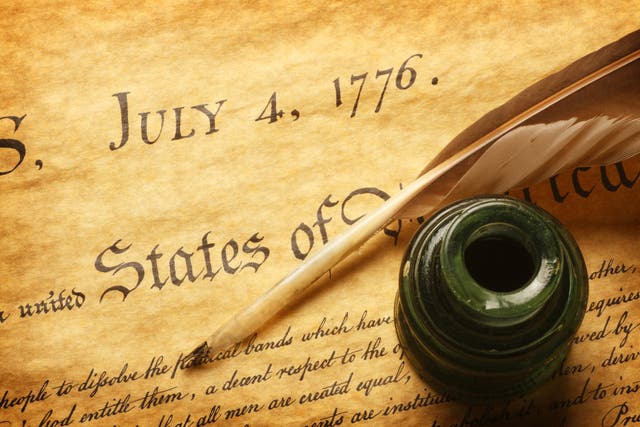

At the Second Continental Congress during the summer of 1776, Thomas Jefferson of Virginia was charged with drafting a formal statement justifying the 13 North American colonies’ break with Great Britain. A member of a committee of five that also included John Adams of Massachusetts, Benjamin Franklin of Pennsylvania, Robert Livingston of New York and Roger Sherman of Connecticut, Jefferson drew up a draft and included Franklin’s and Adams’ corrections. At the time, the Declaration of Independence was regarded as a collective effort of the Continental Congress; Jefferson was not recognized as its principal author until the 1790s.
Born into one of the most prominent families in Virginia (on his mother’s side), Jefferson studied at the College of William and Mary in Williamsburg and began practicing law in 1767. In 1768, Jefferson stood as a candidate for the Virginia House of Burgesses; he entered the legislature just as opposition was building to the taxation policies of the British government. That same year, Jefferson began building Monticello, his hilltop estate in Albemarle County; he would later greatly expand his holdings in land and slaves through his marriage to Martha Wayles Skelton in 1772.
America’s earliest founding document survived war, fire, mistreatment, insects and the ravages of time prior to landing at its current home in the National Archives.
The document was designed to prove to the world (especially France) that the colonists were right to defy King George III's rule.
The Founding Fathers were fighting for freedom—just not for everyone.
According to an account Jefferson wrote in 1823, the other members of the committee “unanimously pressed on myself alone to undertake the draught [sic]. I consented; I drew it; but before I reported it to the committee I communicated it separately to Dr. Franklin and Mr. Adams requesting their corrections…I then wrote a fair copy, reported it to the committee, and from them, unaltered to the Congress.”
The body of Jefferson’s draft contained a list of grievances against the British crown, but it was its preamble to the Constitution that would strike the deepest chords in the minds and hearts of future Americans: “We hold these truths to be self-evident; that all men are created equal; that they are endowed by their Creator with certain inalienable rights; that among these are life, liberty and the pursuit of happiness; that to secure these rights, governments are instituted among men, deriving their just powers from the consent of the governed.”
The Continental Congress reconvened on July 1, and the following day 12 of the 13 colonies adopted Lee’s resolution for independence. The process of consideration and revision of Jefferson’s declaration (including Adams’ and Franklin’s corrections) continued on July 3 and into the late morning of July 4, during which Congress deleted and revised some one-fifth of its text.
The delegates made no changes to that key preamble, however, and the basic document remained Jefferson’s words. Congress officially adopted the Declaration of Independence later on the Fourth of July (though most historians now accept that the document was not signed until August 2).
History of the Fourth of JulyDelegates from all 13 colonies signed the Declaration of Independence. All were male, white landowners. Two would go on to be president of the United States. One signed his name so large that he became an idiomatic expression. When someone asks you to sign something by telling you to “put your John Hancock here,” they are referencing John Hancock’s outsized signature on the Declaration of Independence. Below are the document's signees:
Connecticut:
Samuel Huntington, Roger Sherman, William Williams, Oliver Wolcott
Delaware:
George Read, Caesar Rodney, Thomas McKean
Georgia:
Button Gwinnett, Lyman Hall, George Walton
Maryland:
Charles Carroll, Samuel Chase, Thomas Stone, William Paca
Massachusetts:
John Adams, Samuel Adams, John Hancock, Robert Treat Paine, Elbridge Gerry
New Hampshire:
Josiah Bartlett, William Whipple, Matthew Thornton
New Jersey:
Abraham Clark, John Hart, Francis Hopkinson, Richard Stockton. John Witherspoon
New York:
Lewis Morris, Philip Livingston, Francis Lewis, William Floyd
North Carolina:
William Hooper, John Penn. Joseph Hewes
Pennsylvania:
George Clymer, Benjamin Franklin, Robert Morris, John Morton, Benjamin Rush, George Ross, James Smith, James Wilson, George Taylor
Rhode Island:
Stephen Hopkins, William Ellery
South Carolina:
Edward Rutledge, Arthur Middleton, Thomas Lynch, Jr., Thomas Heyward, Jr.
Virginia:
Richard Henry Lee, Francis Lightfoot Lee, Carter Braxton, Benjamin Harrison, Thomas Jefferson, George Wythe, Thomas Nelson, Jr.
Thomas Jefferson wasn’t recognized as the principal author of the Declaration of Independence until the 1790s; the document was originally presented as a collective effort by the entire Continental Congress. Jefferson had returned to the Virginia legislature in the late summer of 1776 and in 1785 had succeeded Franklin as minister to France. He served as Secretary of State in the cabinet of President George Washington and later emerged as a leader of a Republican party that championed state’s rights and opposed the strong centralized government favored by Alexander Hamilton’s Federalists.
Elected as the nation’s third president in 1800, Jefferson would serve two terms, during which the young nation doubled its territory through the Louisiana Purchase of 1803 and struggled to maintain neutrality during the Napoleonic Wars between England and France.
Despite his many later accomplishments, Jefferson’s principal legacy to the United States arguably remains the Declaration of Independence, the eloquent expression of liberty, equality and democracy upon which the country was founded. His critics, however, point to Jefferson’s admitted racism, and the negative views (common to wealthy Virginia planters of the time) that he expressed about African Americans during his lifetime.
Meanwhile, recent DNA evidence seems to support much-disputed claims that Jefferson had a longstanding intimate relationship with one of his enslaved women, Sally Hemings and that the couple had several children together. Given these circumstances, Jefferson’s legacy as history’s most eloquent proponent of human freedom and equality–justly earned by his words in the Declaration of Independence–remains complicated by the inconsistencies of his life as a slave owner.
Stream American Revolution documentaries and your favorite HISTORY series, commercial-free.